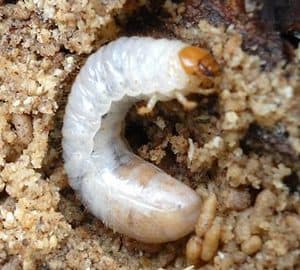
Grubs in the Lawn
The grub is the larvae stage of a variety of beetles – Japanese beetle, European Chafer and June bug are the most common three. European Chafer is the worst one for destroying lawns in our area.
Damage and I.D.
Grubs feed on grass roots causing your lawn to die. The key symptom of grub invasion is irregular dead patches which will lift up easily if tugged on these patches have had the roots severed and there is nothing to anchor the sod in place. The lawn may also have patches that have been burrowed in or been up-turned by moles, skunks or raccoons feeding on grubs. The highest concentration of grubs will be found in live turf bordering dead areas. The grub is “C” shaped with a brown head, white body and six legs on its upper half.
Life cycle
The grub’s life cycle is very simple. The grub feeds on grass roots from mid-March to mid-May, and then develops into its pupa form. The adult beetle emerges in mid-June, mates and retreats back into the soil to lay its eggs. The new grubs hatch and begin to feed in late July to August. The grubs will burrow below the frost line in the fall and stop feeding but if there is a thaw, they will resume feeding at any time, even during the winter. The grubs will continue to feed in the spring, constantly growing larger.
Control
The fall (mid-August to September) is the best time to apply nematodes. These parasitic microscopic organisms feed on the grubs, killing them before they have a change to do serious damage to the lawn.
If you are spraying in the late summer – fall, a spring treatment may be necessary, as all of the grubs may not have been killed the year before.
Cultural Control
When a lawn is well maintained, well watered and well fertilized, there may be grubs present but because the lawn is so vigorous, it will grow more roots as they are destroyed. You may not even detect a problem and if you do, the damage will not be as severe.
